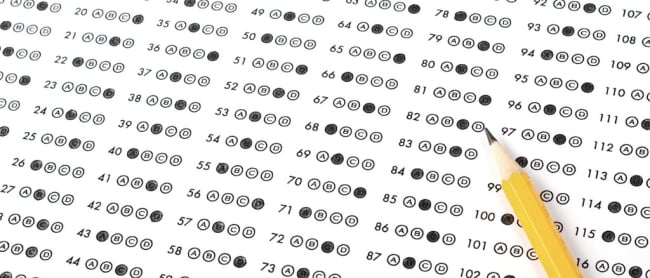You have /5 articles left.
Sign up for a free account or log in.

iStock
These days there is much discussion about colleges going test-optional in admissions, and relying primarily on high school grades for evaluating applicants' academic potential. But what if colleges went in the other direction -- and made decisions only on the basis of SAT or ACT scores?
The Georgetown University Center on Education and the Workforce decided to conduct what it called a "thought experiment" on such a system. And that experiment found that the use of test scores alone would result in a significantly different student body -- more white and more wealthy -- than is admitted now.
No colleges admit applicants that way. And the College Board and ACT urge colleges to make admissions decisions in which their tests are one factor, but not the sole factor.
But the findings, released Sunday, challenge some ideas about affirmative action and college admissions. And the idea may not be as far-fetched as it appears. Some of the rhetoric used by critics of affirmative action suggests that there should be clear, numerical definitions of merit. And a fierce debate is raging in New York City over the system in which a single test determines who gets into highly competitive public high schools -- a system in which a majority of those admitted are Asian Americans, and in which black and Latinx enrollments are quite small. In college admissions, even if test scores are but one factor, the report from Georgetown notes that many applicants and parents obsess over these scores.
Here's how Georgetown researchers did the study:
- They examined test scores of those who graduated from high school in 2013 who enrolled in the 200 most selective colleges in the United States, as defined by Barron's.
- They calculated the total number of spots in those colleges' freshman classes.
- Then they ranked all of the students by their SAT scores (for those who took the ACT, the researchers converted to an equivalent SAT score), tracking by race and socioeconomic groups.
- They then looked at the pool of new students that resulted, in which students needed a 1250 SAT score to be admitted to one of the most competitive 200 colleges.
There are obvious limitations to this approach, as noted in the report. For starters, the levels of competitiveness of the colleges that are most competitive are quite different from those at the bottom end of the top 200.
Here are key findings from the study:
- A little more than half (53 percent) of those admitted would not be those being admitted today. These are the students with SAT scores below 1250.
- The resulting student body would be wealthier, on average, than the current student body. In the class studied, 60 percent came from the top quartile in socioeconomic status, but in a test-only system, 63 percent would come from that bracket.
- The big change would be enrollment by race. The white share would go from 66 percent to 75 percent. The combined black and Latinx enrollment would drop from 19 to 11 percent. The Asian share would drop from 11 to 10 percent.
"Our data confirms that the affluent have extraordinary advantages in college admissions," says the report from the researchers.
The decline for Asian Americans may be surprising, given that year after year, data from the College Board show Asian Americans earning higher scores, on average, than other groups on the SAT, and having their average scores go up, on average, more than those of other groups. And data in the Harvard University admissions litigation suggest that Asian Americans do better when evaluated on academic criteria alone (at that university) than when other factors (including status as legacies or athletes) are factored in.
Jeff Strohl, director of research at the Georgetown University Center on Education and the Workforce, said in an interview that it was hard to be certain why the Asian numbers would decline. The study did not indicate what factors were positive in evaluating the applicants who were admitted with all factors considered, not just test scores.
But Strohl said that he suspected that a key factor was the high rates of Asian Americans (compared to other groups) who apply to top colleges. As a result, many of those applicants were in the original pool.
He added that the data raise questions about a stereotypical view of affirmative action -- namely that many black and Latinx students with low test scores are being admitted. The Georgetown study found that the average test scores for those who would have lost spots under this thought experiment were similar across racial and ethnic groups.
Of the enrolled students who would not have been admitted in a test-only system, 27 percent are black or Latinx, while 35 percent are affluent and white. The median SAT score for those who had been admitted but wouldn't have based on test scores were 1120 for black and Latinx students, 1130 for Asian Americans and 1140 for white people.
Questions From College Board
The College Board questioned why this study was done, given that colleges do not admit applicants based on test scores alone.
Barbara Gill, associate vice president for enrollment management at the University of Maryland at College Park and chair of the College Board's board, said via email: "No one is advocating for SAT-only admissions, which is why conducting a study like this doesn’t make sense and is misleading. Families should know that this study has nothing to do with the way admissions is practiced in modern times in the United States."
A statement from the College Board said: "The SAT does not and should not measure excellence on its own. Data are overwhelming that grades and test scores together better predict college success than either does alone. Comprehensive research demonstrates that sustained commitment to an activity in high school outside of class further predicts success in college and beyond. Resourcefulness in response to challenges has long been honored in college admissions as a dimension of merit and success in life. A focus on a single score would leave so much talent unseen."








